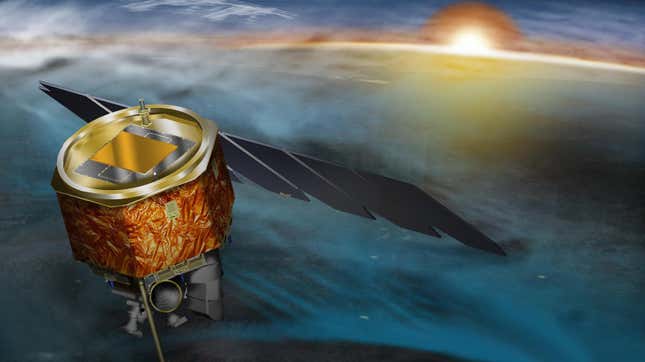

NASA Probe Retires From Observing Clouds at the Edge of Space
source link: https://gizmodo.com/nasa-aim-probe-retires-observing-clouds-edge-space-1850237831
Go to the source link to view the article. You can view the picture content, updated content and better typesetting reading experience. If the link is broken, please click the button below to view the snapshot at that time.

RIP AIM: NASA Probe Retires From Observing Clouds at the Edge of Space
NASA's AIM mission spent 15 years studying the mesosphere before calling it quits due to battery issues.

For the past 15 years, a small NASA spacecraft has explored the edge of space, probing the elusive clouds that form in Earth’s mesosphere. But the spacecraft is no longer operating the way it used to, forcing the team to end its mission.
NASA’s Aeronomy of Ice in the Mesosphere, or AIM, officially wrapped up operations after a loss of battery power that rendered it unable to transmit data, the space agency declared on Thursday.
AIM started experiencing issues with its batteries back in 2019, yet the spacecraft was still considered healthy enough to be able to return a decent amount of data back to ground control. But things have recently gotten worse for AIM, and the spacecraft hasn’t even been able to collect data, let alone receive commands from mission control, according to NASA. Unfortunately, it’s not possible for NASA to change the battery on AIM—a spacecraft that’s orbiting 370 miles (595 kilometers) above Earth’s surface.
The team behind the mission has called it quits, although they “will continue to monitor AIM’s communication for two weeks in case the spacecraft is able to reboot and transmit a signal,” NASA wrote in its statement.
AIM launched on April 25, 2007, and has been orbiting Earth in a near-circular, Sun-synchronous orbit, which means it crosses above any given point on our planet at the same local time. From its vantage point, AIM looks down on Earth’s highest clouds that form over the North and South poles. The goal is to figure out why these night-shining clouds, which can only be seen near twilight, form.
The mission was only slated to operate for two years, but clearly ran way past its expiry date. During its orbital stint, data collected by AIM led to 379 peer-reviewed scientific papers. Bye AIM—you sure had quite the run.
For more spaceflight in your life, follow us on Twitter and bookmark Gizmodo’s dedicated Spaceflight page.
Recommend
-
 7
7
SpaceNASA probe that ‘touched the sun’ for first time could help people better understand the solar systemListen to article
-
 9
9
Chinese Rover Reaches Mysterious Moon Cube: It's a RockWe can’t say we weren’t warned about the "mystery hut" on the far side of the Moon. January 7, 2022, 4:07pm
-
 7
7
June 21, 2022 ...
-
 3
3
NASA Wants Your Help Analyzing the Juno Probe’s Photos of Jupiter June 27, 2022 ...
-
 5
5
MediaVince McMahon retires as WWE chief amid probes into alleged misconduct of pro wrestl...
-
 6
6
SpaceflightNASA’s Moonbound CAPSTONE Probe Is Stuck in Safe ModeThe 55-pound probe entered safe mode during a trajecto...
-
 7
7
The 747 is out. Green airplanes are in. NASA has a plan to “skip a generation” of passenger aircraft design to fight climate change. ...
-
 7
7
Spaceflight15-Year-Old NASA Probe Back in Action After Systems ResetThe IBEX spacecraft, in space since 2008, stopped...
-
 12
12
NASA's Voyager 1 Probe In Interstellar Space Can't Phone Home binspam
-
 12
12
Home / News / NASA’s Parker Solar Probe set to make record-breaking approac...
About Joyk
Aggregate valuable and interesting links.
Joyk means Joy of geeK